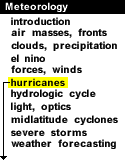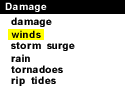
|
Strong winds are the most common means of destruction associated with hurricanes. Their sometimes continuous barrage can uproot trees, knock over buildings and homes, fling potentially deadly debris around, sink or ground boats, and flip cars.
The intensity of a tropical cyclone is measured by the highest sustained wind speed found within it. Once it becomes a hurricane, the relative strength of that hurricane is also measured on a scale based on its greatest wind speed. This scale is named the Saffir-Simpson scale for the men who invented it. The scale is listed below.
| Category |
mb inches |
mi/hr knots |
feet meters |
Damage |
| 1 | >=980
>=28.94 |
74-95
64-82 |
4-5
~1.5 |
some damage to trees, shrubbery, and unanchored mobile homes |
|---|---|---|---|---|
| 2 | 965-979
28.50-28.91 |
96-110
83-95 |
6-8
~2.0-2.5 |
major damage to mobile homes; damage buildings' roofs, and blow trees down |
| 3 | 945-964
27.91-28.47 |
111-130
96-113 |
9-12
~2.5-4.0 |
destroy mobile homes; blow down large trees; damage small buildings |
| 4 | 920-944
27.17-27.88 |
131-155
114-135 |
13-18
~4.0-5.5 |
completely destroy mobile homes; lower floors of structures near shore are susceptible to flooding |
| 5 | <"920"
<"27.17" |
>"155"
>"135" |
>"18"
>"5.5" |
extensive damage to homes and industrial buildings; blow away small buildings; lower floors of structures within 500 meters of shore and less than 4.5 m (15 ft) above sea level are damaged |
The Saffir-Simpson scale categorizes hurricanes on a scale from 1 to 5. Category 1 hurricanes are the weakest, and 5's the most intense. Hurricanes strong enough to be considered intense start at category 3 or with sustained winds exceeding 96 knots (111 mph). For reference, there have only been three category 5 hurricanes that made landfall on the mainland U.S. (Florida Keys 1935, Camille 1969, and Andrew 1992).
Not only can the winds be dangerous, but the fact that they continually blow upon the water creates another problem - storm surge and high waves. Storm surge and high waves can contribute to water rising as high as 30 feet -- easily enough to devastate homes and businesses along the shore as well as kill those within them. Coastal towns adjacent to large bays or areas with shallow water are especially susceptible to damage by the storm surge.

damage |
|

storm surge |




